The history of 0666 TR, and the 250 Testa Rossa program at large, are rooted in the broader context of international motor sport during the late 1950s.
With Mercedes-Benz out of the picture, the highest levels of sports car racing consisted of an escalating battle between Ferrari and Maserati for top honors, punctuated by the increasingly effective efforts of Jaguar, Porsche and Aston Martin.
Due to the ever-increasing speeds of the Italian entries, the Commission Sportive Internationale imposed new classifications designed to simultaneously level the playing field and make racing a safer proposition for all involved.
In addition to this challenge, Scuderia Ferrari was also forced to reconsider its profitable marketplace in the US. Given the SCCA’s structure, the firm’s popular four-cylinder 500 TRC had little hope of ever attaining an outright victory.
As is the nature of a true competitor, Scuderia Ferrari forged ahead in what appeared to be a grueling war on two distinctly different fronts. In so doing, they created one of the greatest sports racing cars in history, the 250 Testa Rossa.
Using the template put forward by Aston Martin’s DBR1, Ferrari set to work developing a three-liter sports car with a reliable, production- based power plant, lithe aerodynamic bodywork and forgiving handling traits. It needed to be a viable works-team car as well as an enticing candidate for American privateers.
The development of the Ferrari 250 TR began in early 1957 with the car presented here, 0666 TR.
As a result, 0666 TR has the significant distinction of serving as the first prototype for the 250 Testa Rossa series, an exclusive group of Ferraris that went on to dominate sports car racing for the next five years.
0666 TR was constructed on the tipo 525 chassis, complete with a De Dion tube, transverse leaf-spring suspension in the rear, and A-arms and coil springs up front. As a works-team car, it was specified in a right-hand-drive arrangement. The first engine installed was of the contemporary 250 GT-type, tuned to an even hotter state than the potent, factory-prepared Tour de France Berlinettas. Finally, the completed chassis was draped in fully enveloping coachwork, similar in style to the 290 MM models of 1956.
When it was completed in May 1957, the Testa Rossa prototype looked as though it had been assembled in great haste, with visible hammer marks in the panels, last-minute alterations and varying shades of red paint. In short, it was an appearance not customarily seen on Ferrari-works entries.
Nevertheless, 0666 TR made its debut at the ADAC 1000 Km Nürburgring and, despite its rather experimental finish, the original TR prototype was certainly in healthy tune. During practice, the Scuderia Ferrari-works drivers all had a chance to try out the new race car, including Phil Hill, who had only recently joined the factory team. In the capable hands of Olivier Gendebien, 0666 TR recorded the sixth fastest time in qualifying, just behind the large-displacement Ferrari and Aston Martin works entries.



Masten Gregory, known as “The Kansas City Flash,” was hired specifically to drive the prototype along with Gendebien. After a confusing driver shuffle, Gregory left believing he would return in the morning as a spectator, not as an entrant. When a frenzied Ferrari mechanic burst into Gregory’s hotel room moments before the start, he was proven wrong.
Arriving at the ’Ring just in time, the disheveled Gregory hopped into his similarly groomed mount and set off at a rapid pace. After a few laps, he was running as high as 6th, hot on the heels of the established competition.
Eventually, Gregory handed over the controls to Olinto Morolli, a relatively untested driver who Scuderia Ferrari had temporarily spirited away from his OSCA. Having no time to practice in the new prototype and very little experience with the track, Morolli put on a disappointing performance, recording lap times some three minutes slower than Gregory! As a result, 0666 TR continued to slip in position, yet its strong start helped it finish 10th overall. It was an impressive debut to be sure.
Returning from Germany, the prototype was prepared for its next outing and, on June 13th, the factory Certificate of Origin was issued for 0666 TR.
During July, the Testa Rossa underwent further development and next appeared at the Swedish 6-hour Grand Prix in Kristianstad, where it was equipped with the experimental 3.1-liter engine that had recently been tested at Le Mans.
For that race, the factory assigned Gendebien and Maurice Trintignant to the prototype. However, after an hour and a half of racing, the engine, suffering from various ailments, gave out and the car was forced to retire.
By the time 0666 TR returned from Scandinavia, the CSI had confirmed the new three-liter limit for the 1958 season. Between September and October 1957, 0666 TR was stripped of its envelope body and refinished by Scaglietti in the quintessential pontoon-fender style, with inside door hinges and an air vent installed on the right side between the fender and hood.
At that time, the prototype received its definitive driveline, complete with the tipo 128 LM Testa Rossa motor (No. 0666 TR, Internal No. GES N 6) and four-speed gearbox.
Ferrari 250 Testa Rossa – Car Profile Page Two
In October 1957, the updated 250 TR was loaded onto a boat at the Genova docks, destined for South America. On November 3rd, before Ferrari officially announced the arrival of the 250 Testa Rossa, this car participated in the Venezuelan Grand Prix at Caracas.
As Caracas was the deciding race of the 1957 World Championship season, Ferrari sent along two 335 S models, as well as its TR prototypes. Count Wolfgang von Trips and Wolfgang Seidel were entrusted with 0666 TR, piloting it to an outstanding 3rd overall behind the giant 4.1-litre four-cam Ferraris. The Maseratis were all but destroyed in the effort. Ferrari had won the 1957 Manufacturer’s Championship and 0666 TR’s podium finish appeared promising for the 1958 season.
After Caracas, the Testa Rossa was left in the care of Ferrari’s South American distributor, Carlos Kaufman, who transported it to Argentina to take part in the first race of the 1958 season, the 1000 Km Buenos Aires held on the 26th of January.
Running alongside four other Testa Rossas – two Scuderia Ferrari team cars and two private entries – 0666 TR was driven by Von Trips, Gendebien and Luigi Musso to an impressive 2nd overall behind the winning team car of Phil Hill and Peter Collins.
The Targa Florio proved to be the last outing for 0666 TR as a Scuderia Ferrari team car. Held on May 11th, the great Italian road race was certainly a challenge of the new Testa Rossa’s stamina, as it demanded 40 arduous laps around the 45-mile Little Madonie circuit.
For this race, the two fastest team cars, 0666 TR and 0726 TR, were equipped with an experimental intake setup consisting of six Solex twin-choke carburetors. This unusual specification was purported to produce a dizzying 330 bhp, albeit with a severely limited power band.
Scuderia Ferrari assigned Wolfgang Seidel and Gino Munaron to drive 0666 TR and the pair drove a beautiful race until the very last lap. While maintaining 4th place, Seidel went off course and slid into a rocky patch. Despite his immediate return to the road, the adventure had torn a hole in the oil sump and the engine quit a mere 5 km from the finish. It was an unlucky end to an otherwise brilliant display.




That year, Le Mans was plagued by a devastating storm that caused great attrition. Around 10 p.m., in the dark and rain, Bruce Kessler collided with a privately entered D-Type Jaguar, resulting in a fire and the Testa Rossa’s subsequent retirement.
The incident required a comprehensive rebuild at the factory and a fresh pontoon-fender body from Scaglietti.
By the beginning of the 1959 season, Ferrari had constructed three new team cars, dubbed the TR59s, and signed Dan Gurney as a factory- team driver. Chinetti realized that 0666 TR would likely not be competitive enough for his needs and the beautifully finished TR prototype was offered for $12,500.
On March 9, 1959, 0666 TR entered a new phase of its career when it was sold to Rod Carveth, a talented privateer from San Carlos, California.
A high-performance parts distributor, Carveth had started racing in the early 1950s – first with Allards and Triumphs – before graduating to Aston Martin’s DB3S. In 1959, after capturing some 40 trophies and a prestigious SCCA Racing Driver’s Award, he began the search for a more serious machine.
After his quest for a DBR1 proved fruitless, he purchased this Testa Rossa and entered the former Ferrari team car in the 8th Annual 12 Hours of Sebring on the 21st of March.
Finished in a handsome silver-blue livery with a white center stripe, 0666 TR was listed as an official NART entry with Carveth and Gil Geitner driving. Racing in foul weather, the Testa Rossa kept within the top 10 until the late afternoon, when it ran out of fuel and rolled to a stop about a mile past the pits. Ever the competitor, Carveth single-handedly pushed the Ferrari for the four miles around the course so that it could be refueled. Sadly, an hour later, Carveth caught a rain-filled marker barrel, damaging the headlamps, thus ending its chance at an evening run.
After Sebring, 0666 TR was carefully prepared and shipped to the Nürburgring for the famed 1000 km event. While running in 8th place on the last lap, Geitner spun in the privately entered Testa Rossa at the Karussel, ending up in a ditch, unable to extract the car in time to continue racing.
In June of that year, the Ferrari traveled to Le Mans for the second time. In a race that saw most of the factory Testa Rossas suffer from mechanical trouble, Carveth’s mount fared no better. In the middle of the night, the engine failed while attacking the Mulsanne straight.
In early 1960, after a brief sojourn to Australia, 0666 TR settled at Rod Carveth Enterprises in California, its bodywork finished in metallic blue with a distinctive noseband.
With three years of experience at the top levels of international racing, the Testa Rossa was poised to take on the local competition in regional SCCA events. Shortly after returning to the US, it was entered in the Laguna Seca Examiner Grand Prix. Despite the best efforts of Phil Hill, the Testa Rossa’s Le Mans gearing proved a terrible burden at the twisting course and it failed to qualify.
In April 1960, after shorter ratios had been installed, 0666 TR raced at Cotati Raceway near San Francisco, where Chuck Howard drove it to a 3rd overall with a win in the 1,500+ Modified category. From there, Carveth ran the Ferrari at the Port of Stockton SCCA Regional event, finishing 5th in the B – E Modified race. The final race of 1960 took place at Laguna Seca, and 0666 TR finished 10th overall.

Over the Winter, Carveth’s Ferrari was prepared for the following season, the most notably visible addition being a spare hood in the style of the TR59, with a clear Plexiglas bulge above the carburetors.
Evidently, the development work paid off. On July 15, 1961, Carveth and Charlie Parsons won the 3-Hour Enduro at Cotati outright, trouncing the entire 45-car field. Following that success, Lew Florence drove the Testa Rossa to a 6th overall at Vacaville on August 20th. After a second outing at Cotati in November, the Testa Rossa was retired until the following season.
Carveth’s last outing in 0666 TR took place on April 15, 1962, at Stockton. Although he finished a credible 11th, the skilled driver couldn’t help but notice the increasing competition from mid-engine cars. Having raced the Testa Rossa throughout Europe and on both coasts of the US, he offered the car for sale, placing it in the window of his small San Carlos shop.
Enter 0666 TR’s fourth owner, Bev Spencer.
Ferrari 250 Testa Rossa – Car Profile Page Three
A wealthy California entrepreneur, Bev Spencer was brought up in the car business and ran Spencer Buick, his family’s San Francisco showroom. After attending the early Pebble Beach races, he was bitten by the European sports car bug and, in 1955, purchased a 300 SL Gullwing. Shortly after, he began moving through a succession of road Ferraris: 166 MM, 212, 340 America, 410 Superamerica, California Spider and so on.
Possibly the greatest automotive influence on Spencer during that time was his friendship with fellow Californian Phil Hill, whose legendary drives for Ferrari, especially during the golden three-liter era, inspired Spencer to purchase a competition car.
In May 1962, Spencer traveled a short distance to Rod Carveth Enterprises and purchased the venerable Testa Rossa, still finished in its light blue racing livery accented by various racing stickers.
The competition Ferrari was then driven home along Highway 101 with Spencer at the wheel, dressed in his typically conservative business suit. According to a lovely retrospective written by Spencer’s son Roy, when the raucous Testa Rossa arrived at the Spencer home, “there were rides for the seven children and apologies to the neighbors.”
Registered on yellow California plates, the beautifully finished ex-works Testa Rossa became Spencer’s personal street car, a perfect complement to his other Ferrari, a LWB California Spider. On Sunday morning outings, he would peer into the garage and be struck by the rather tricky question of which car to drive.
In 1963, Spencer became an official Ferrari franchise and renamed the family dealership Spencer Buick-Ferrari – an amusing combination, to say the least. In May of that year, Steve Earle of Santa Barbara advertised 0666 TR for sale in Road & Track, right around the time that Spencer took delivery of his new 250 GTO.
The last known race for the Testa Rossa was in May 1964 at an SCCA event at Santa Barbara. This anticlimactic outing marked the end of a sensational eight-year racing career that saw the Testa Rossa go from a factory-team car competing at the world’s great venues, to a private entrant in regional SCCA races, battling much newer cars on the makeshift tracks of Central California.



After the original engine finally gave out, it was removed from the car and traded to Pete Lovely with a package of Lotus racing spares, leaving the Testa Rossa to sit quietly in a California garage. When its then-owner believed the aging Ferrari was worth more in cash than as a car, he doused the interior in gasoline and set it on fire. While it was enough to collect the insurance money, the result was little more than a superficial burn. Photos taken shortly after illustrate the original aluminum coachwork intact, albeit in need of some restoration.
On September 27, 1970, Charles Betz and Fred Peters purchased the Testa Rossa from Pete Civati of Los Angeles. As the leading Ferrari experts on the West Coast, Betz and Peters were keenly aware of the car’s significant past. Over the next decade, 0666 TR was meticulously restored to a show-quality standard using an appropriate engine from 0724 TR.
By the late 1980s, the restoration was complete and 0666 TR began collecting significant concours awards. Between 1988 and 2002, the Testa Rossa earned First in Class honors at Pebble Beach, Santa Barbara and Newport Beach. At the 1994 International Ferrari Concours d’Elegance and FCA annual meet, it took Best in Class and People’s Choice. As recently as 2001, 0666 TR achieved Platinum level in FCA judging and was presented the Phil Hill Award for outstanding service to road racing.
In 2002, after three decades with the Testa Rossa, Betz and Peters sold it to the current caretaker, a preeminent collector with a passion for Italian automobiles.
After several seasons of vintage racing, the owner commissioned Dennison International to complete a restoration that would bring 0666 TR back to its original team car appearance and specification. Instrumental to this project was a significant acquisition: the original, matching-numbers engine and a correct rear differential.
Between February 2005 and July 2006, 0666 TR was returned to its former splendor, with great care taken to ensure authenticity and exemplary attention to detail in every respect. Regarded by many as the finest Ferrari specialists in the US, the skilled team of Dennison International was given free reign throughout the process to prepare the Testa Rossa for further concours and vintage racing competition.

In its freshly restored form, the prototype 250 TR made its debut in August 2006 at the Pebble Beach Concours d’Elegance. Having impressed the judges with its historical significance and remarkable originality, 0666 TR earned a prestigious First in Class, a deserving honor for this legendary car.
In preparation for the Cavallino Classic in January 2007, the Ferrari was refinished in its 1958 NART Le Mans livery, complete with the patriotic center stripe and large roundels. In this ensemble, the Testa Rossa caused quite a stir and took home an FCA Platinum Award as well as the coveted TR Cup.
This remarkable streak continued onto the 2007 Ferrari Club of America Annual Meet in Corning, New York, where the Testa Rossa received the Coppa Bella Macchina award, the Coppa GT award and its second Phil Hill Award. These are the most impressive achievements in FCA competition. Last shown at the Carmel-by-the-Sea Concours in August 2009, this sensational Ferrari received both a First in Class award and Best in Show honors.
Ferrari 250 Testa Rossa – Car Profile Page Four
Having garnered innumerable accolades from leading Ferrari experts, Pebble Beach judges, journalists, pundits and enthusiasts alike, 0666 TR’s grand tour culminated in an appearance on the cover of Cavallino magazine (Issue 170) in 2009.
Beyond its warm reception on the concours circuit, the Testa Rossa has remained active in vintage racing, participating in the Coronado Speed Festival, the Northwest Historic Races and the Rolex Monterey Historics. Those interested in campaigning 0666 TR should note that the sale is accompanied by a collection of racing components that includes four wheels and tires, a differential, ring and pinion, drive gears and a racing fuel cell, as well as a complete, spare race engine that is reported to produce over 300 hp.
When the Ferrari Classiche department was established, the current owner seized the opportunity to have this historic car inspected and evaluated by its maker. As a testament to the reputation of both caretaker and car, members of the Classiche department traveled from Italy to the owner’s facility where they performed a meticulous, detailed inspection of the prototype Testa Rossa.
In December 2008, after all necessary information was gathered and analyzed, the Certificate of Authenticity was issued for the Testa Rossa prototype, confirming that the chassis, body and engine are all original to 0666 TR. To date, the Ferrari Classiche program has certified just one pontoon-fender 250 Testa Rossa team car, 0666 TR.

Further attesting to the Testa Rossa’s rich heritage is a remarkable collection of archival material. Nearly every major outing has been captured in photographs, and the books that feature this Testa Rossa are simply too numerous to count. Offered with the sale are both sets of original build sheets, the first attesting to its service as a Scuderia Ferrari team car and the second, printed in purple ink, marking its sale to Luigi Chinetti in 1958. Finally, noted Ferrari historian Marcel Massini has produced a detailed history report of this car tracing its remarkable journey since its inception.
As the original prototype for the 250 Testa Rossa, 0666 TR will always carry a special significance, having served as the original test bed for one of the greatest series of sports racing cars. While earlier Ferrari models found their niche, it was the profound success of the 250 TR that cemented the firm’s reputation as the ultimate manufacturer of racing machines, doing so during one of the great eras in the history of motor sport. Today, a Testa Rossa is immediately recognizable to anyone with even a passing interest in automobiles.
Not only were the Testa Rossas hugely successful in competition, the early pontoon-fender versions are widely considered to be the most beautiful, radically styled automobiles ever to race. It is no wonder that Sergio Scaglietti considered the design to be his finest work for Ferrari. In their combination of aesthetic brilliance and technical superiority, these exceptional Ferraris epitomize the glory and bravado found in the greatest Italian sports cars.
Given their hand-built nature and varied applications, no two examples are the same, each bearing its own character and unique details. Without a doubt, 0666 TR is one of, if not the most attractive of this exclusive group. Its sinuous lines, voluptuous forms, large front grille and seductive details stand out as being especially refined and elegant when compared to its brethren.
During its spectacular eight-year career, 0666 TR accomplished everything Ferrari set out to achieve with the Testa Rossa program. Not only is it the only 250 TR to capture podium finishes in 1957 and 1958 – years in which Ferrari won the World Sportscar Championship – but the prototype also continued to race in international events for three years and dominated its class in West Coast SCCA events.

Throughout that period, this Ferrari was raced by some of the greatest drivers of the post-war era: Gregory, Von Trips, Gendebien, Seidel, Gurney, Musso, Hill, Kessler and Carveth. As a factory-team car, NART entrant and privateer, it left its mark on three continents, competing at Nürburgring, Buenos Aires, Caracas, Targa Florio, Sebring, Laguna Seca and Le Mans.
With its prototype status, exquisite beauty, proud race record and uncommon authenticity, 0666 TR must be considered one of the great Ferrari sports racing cars, and thus, one of the finest competition cars of the post-war era.
Since 1970, just two caretakers have had the immense privilege of owning this magnificent Ferrari – the fortunate new owner will be acquiring an exceptionally rare prize.
This 1957 Ferrari 250 Testa Rossa Prototype, chassis number 0666TR, sold for $16,390,000 at the 2012 Gooding and Company Pebble Beach sale, held August 20-21 in Pebble Beach, California. The price represented a world record for an automobile sold at public auction.
Auction Editor Rick Carey reported on 0666TR:

[Source: Gooding & Company; photos: ©2011 Pawel Litwinski]


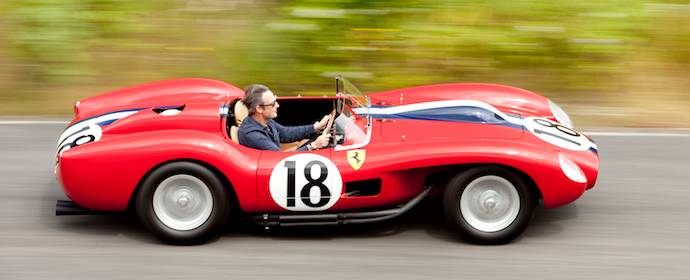
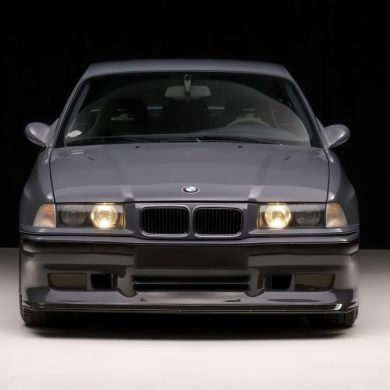

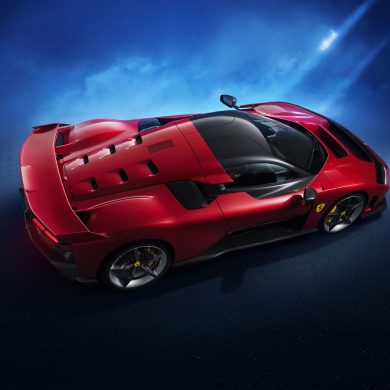
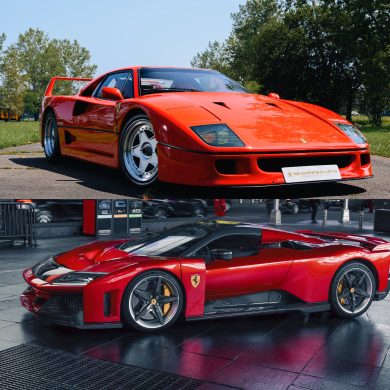
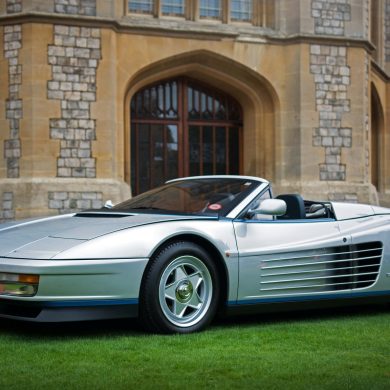
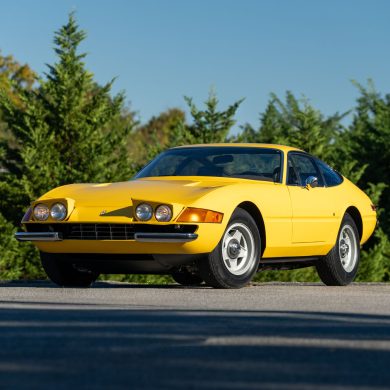


Wonderful article. I’ve often wondered what became of this car. Growing up in Belmont, CA, next door to San Carlos, I saw this car run in many of the West Coast races mentioned. I recall stopping by Rod Carveth Enterprises on El Camino Real one day to pick up a part for my MG-A and seeing this very car up for sale. If memory serves, I had enough money in the bank to buy it – it was, after all, a used-up race car. I don’t know what I would have done with it over the ensuing years, but I don’t think I would have set it on fire.